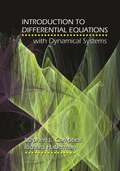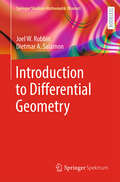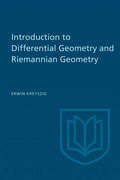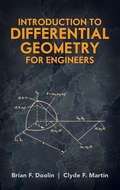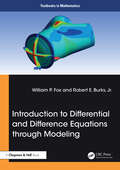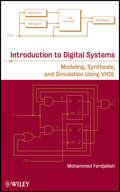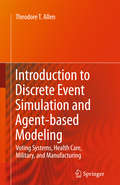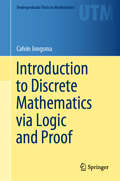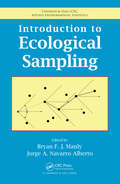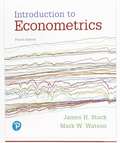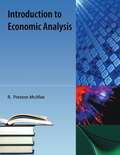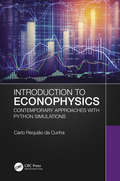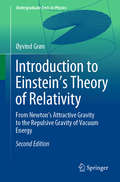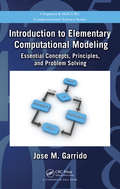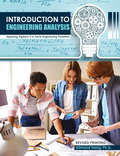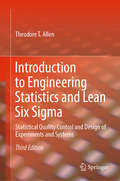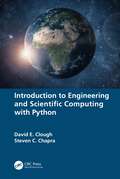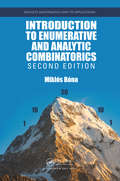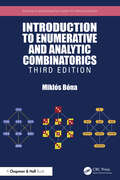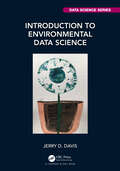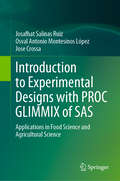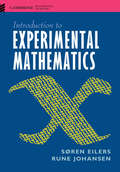- Table View
- List View
Introduction to Differential Equations with Dynamical Systems
by Richard Haberman Stephen L. CampbellMany textbooks on differential equations are written to be interesting to the teacher rather than the student. Introduction to Differential Equations with Dynamical Systems is directed toward students. This concise and up-to-date textbook addresses the challenges that undergraduate mathematics, engineering, and science students experience during a first course on differential equations. And, while covering all the standard parts of the subject, the book emphasizes linear constant coefficient equations and applications, including the topics essential to engineering students. Stephen Campbell and Richard Haberman--using carefully worded derivations, elementary explanations, and examples, exercises, and figures rather than theorems and proofs--have written a book that makes learning and teaching differential equations easier and more relevant. The book also presents elementary dynamical systems in a unique and flexible way that is suitable for all courses, regardless of length.
Introduction to Differential Geometry (Springer Studium Mathematik (Master))
by Joel W. Robbin Dietmar A. SalamonThis textbook is suitable for a one semester lecture course on differential geometry for students of mathematics or STEM disciplines with a working knowledge of analysis, linear algebra, complex analysis, and point set topology. The book treats the subject both from an extrinsic and an intrinsic view point.The first chapters give a historical overview of the field and contain an introduction to basic concepts such as manifolds and smooth maps, vector fields and flows, and Lie groups, leading up to the theorem of Frobenius. Subsequent chapters deal with the Levi-Civita connection, geodesics, the Riemann curvature tensor, a proof of the Cartan-Ambrose-Hicks theorem, as well as applications to flat spaces, symmetric spaces, and constant curvature manifolds. Also included are sections about manifolds with nonpositive sectional curvature, the Ricci tensor, the scalar curvature, and the Weyl tensor. An additional chapter goes beyond the scope of a one semester lecture course and deals with subjects such as conjugate points and the Morse index, the injectivity radius, the group of isometries and the Myers-Steenrod theorem, and Donaldson's differential geometric approach to Lie algebra theory.
Introduction to Differential Geometry and Riemannian Geometry (Mathematical Expositions #16)
by Erwin KreyszigThis book provides an introduction to the differential geometry of curves and surfaces in three-dimensional Euclidean space and to n-dimensional Riemannian geometry. Based on Kreyszig's earlier book Differential Geometry, it is presented in a simple and understandable manner with many examples illustrating the ideas, methods, and results.<P><P> Among the topics covered are vector and tensor algebra, the theory of surfaces, the formulae of Weingarten and Gauss, geodesics, mappings of surfaces and their applications, and global problems. A thorough investigation of Reimannian manifolds is made, including the theory of hypersurfaces. <P> Interesting problems are provided and complete solutions are given at the end of the book together with a list of the more important formulae. Elementary calculus is the sole prerequisite for the understanding of this detailed and complete study in mathematics.
Introduction to Differential Geometry for Engineers (Dover Civil and Mechanical Engineering)
by Brian F. Doolin Clyde F. MartinThis outstanding guide supplies important mathematical tools for diverse engineering applications, offering engineers the basic concepts and terminology of modern global differential geometry. Suitable for independent study as well as a supplementary text for advanced undergraduate and graduate courses, this volume also constitutes a valuable reference for control, systems, aeronautical, electrical, and mechanical engineers.The treatment's ideas are applied mainly as an introduction to the Lie theory of differential equations and to examine the role of Grassmannians in control systems analysis. Additional topics include the fundamental notions of manifolds, tangent spaces, vector fields, exterior algebra, and Lie algebras. An appendix reviews concepts related to vector calculus, including open and closed sets, compactness, continuity, and derivative.
Introduction to Differential and Difference Equations through Modeling (Textbooks in Mathematics)
by William P. Fox Robert E. Burks, Jr.This book presents an opportunity to learn difference and differential equations through a modeling-first approach. The text is meant as an introduction to those equations and not as a text only for modeling courses. No previous exposure to these equations is expected. Modeling in Introduction to Differential and Difference Equations through Modeling is presented as the vehicle for learning difference and differential equations. Although the topics in difference and differential equations are consistent with those in other textbooks, this approach differs. The presentation starts with a model (or several models) and offers the solution with minor discussions. Then, methods to obtain those solutions are presented and show these same models and others again in more detail.This approach is designed to focus on the use of difference and differential equations to solve real-world problems, and to learn not only these primary topics, but how to apply these through modeling.The authors begin with a review of matrix algebra, then an introduction to modeling. The text progresses to discrete dynamical systems, and then to the standard organization of most differential equation texts, making the alignment with a current syllabus easier. Technology is a significant modeling component. Excel®, Python®, and Maple® are presented as methods to solving the models. This material has been class tested at the US Military Academy at West Point, Marian University, the College of William & Mary, and the Naval Postgraduate School with great success.
Introduction to Digital Systems
by Mohammed FerdjallahA unique guide to using both modeling and simulation in digital systems designDigital systems design requires rigorous modeling and simulation analysis that eliminates design risks and potential harm to users. Introduction to Digital Systems: Modeling, Synthesis, and Simulation Using VHDL introduces the application of modeling and synthesis in the effective design of digital systems and explains applicable analytical and computational methods. Through step-by-step explanations and numerous examples, the author equips readers with the tools needed to model, synthesize, and simulate digital principles using Very High Speed Integrated Circuit Hardware Description Language (VHDL) programming.Extensively classroom-tested to ensure a fluid presentation, this book provides a comprehensive overview of the topic by integrating theoretical principles, discrete mathematical models, computer simulations, and basic methods of analysis. Topical coverage includes:Digital systems modeling and simulationIntegrated logicBoolean algebra and logicLogic function optimizationNumber systemsCombinational logicVHDL design conceptsSequential and synchronous sequential logicEach chapter begins with learning objectives that outline key concepts that follow, and all discussions conclude with problem sets that allow readers to test their comprehension of the presented material. Throughout the book, VHDL sample codes are used to illustrate circuit design, providing guidance not only on how to learn and master VHDL programming, but also how to model and simulate digital circuits.Introduction to Digital Systems is an excellent book for courses in modeling and simulation, operations research, engineering, and computer science at the upper-undergraduate and graduate levels. The book also serves as a valuable resource for researchers and practitioners in the fields of operations research, mathematical modeling, simulation, electrical engineering, and computer science.
Introduction to Discrete Event Simulation and Agent-based Modeling
by Theodore T. AllenDiscrete event simulation and agent-based modeling are increasingly recognized as critical for diagnosing and solving process issues in complex systems. Introduction to Discrete Event Simulation and Agent-based Modeling covers the techniques needed for success in all phases of simulation projects. These include: * Definition - The reader will learn how to plan a project and communicate using a charter. * Input analysis - The reader will discover how to determine defensible sample sizes for all needed data collections. They will also learn how to fit distributions to that data. * Simulation - The reader will understand how simulation controllers work, the Monte Carlo (MC) theory behind them, modern verification and validation, and ways to speed up simulation using variation reduction techniques and other methods. * Output analysis - The reader will be able to establish simultaneous intervals on key responses and apply selection and ranking, design of experiments (DOE), and black box optimization to develop defensible improvement recommendations. * Decision support - Methods to inspire creative alternatives are presented, including lean production. Also, over one hundred solved problems are provided and two full case studies, including one on voting machines that received international attention. Introduction to Discrete Event Simulation and Agent-based Modeling demonstrates how simulation can facilitate improvements on the job and in local communities. It allows readers to competently apply technology considered key in many industries and branches of government. It is suitable for undergraduate and graduate students, as well as researchers and other professionals.
Introduction to Discrete Mathematics via Logic and Proof (Undergraduate Texts in Mathematics)
by Calvin JongsmaThis textbook introduces discrete mathematics by emphasizing the importance of reading and writing proofs. Because it begins by carefully establishing a familiarity with mathematical logic and proof, this approach suits not only a discrete mathematics course, but can also function as a transition to proof. Its unique, deductive perspective on mathematical logic provides students with the tools to more deeply understand mathematical methodology—an approach that the author has successfully classroom tested for decades. Chapters are helpfully organized so that, as they escalate in complexity, their underlying connections are easily identifiable. Mathematical logic and proofs are first introduced before moving onto more complex topics in discrete mathematics. Some of these topics include: Mathematical and structural inductionSet theoryCombinatoricsFunctions, relations, and ordered setsBoolean algebra and Boolean functionsGraph theory Introduction to Discrete Mathematics via Logic and Proof will suit intermediate undergraduates majoring in mathematics, computer science, engineering, and related subjects with no formal prerequisites beyond a background in secondary mathematics.
Introduction to Ecological Sampling (Chapman & Hall/CRC Applied Environmental Statistics #10)
by Bryan F. J. Manly Jorge A. Navarro AlbertoAn Easy-to-Understand Treatment of Ecological Sampling Methods and Data AnalysisIncluding only the necessary mathematical derivations, Introduction to Ecological Sampling shows how to use sampling procedures for ecological and environmental studies. It incorporates both traditional sampling methods and recent developments in environmental and ecolo
Introduction to Econometrics
by Mark Watson James StockEnsure students grasp the relevance of econometrics with Introduction to Econometrics -- the text that connects modern theory and practice with motivating, engaging applications. The 4th Edition maintains a focus on currency, while building on the philosophy that applications should drive the theory, not the other way around. The text incorporates real-world questions and data, and methods that are immediately relevant to the applications. With very large data sets increasingly being used in economics and related fields, a new chapter dedicated to Big Data helps students learn about this growing and exciting area. This coverage and approach make the subject come alive for students and helps them to become sophisticated consumers of econometrics.
Introduction to Econometrics: Principles and Applications (3rd Edition)
by Wallace E. Oates Harry H. KelejianIntroduction To Econometrics: Principles And Applications
Introduction to Economic Analysis
by R. Preston McafeeThis book presents introductory economics ("principles") material using standard mathematical tools, including calculus. It is designed for a relatively sophisticated undergraduate who has not taken a basic university course in economics. It also contains the standard intermediate microeconomics material and some material that ought to be standard but is not. The book can easily serve as an intermediate microeconomics text. The focus of this book is on the conceptual tools and not on fluff. Most microeconomics texts are mostly fluff and the fluff market is exceedingly over-served by $100+ texts. In contrast, this book reflects the approach actually adopted by the majority of economists for understanding economic activity. There are lots of models and equations and no pictures of economists.
Introduction to Economic Analysis
by R. Preston Mcafee Tracy R. LewisThis book presents standard intermediate microeconomics material and some material that, in the authors' view, ought to be standard but is not. Introductory economics material is integrated. Standard mathematical tools, including calculus, are used throughout. The book easily serves as an intermediate microeconomics text, and can be used for a relatively sophisticated undergraduate who has not taken a basic university course in economics. The focus of this book is on the conceptual tools and not on fluff. As such, it reflects the approach actually adopted by the majority of economists for understanding economic activity. There are lots of models and equations, and no pictures of economists ;-) Economic analysis is used in many situations. When British Petroleum sets the price for Alaskan crude oil, it uses an estimated demand model, both for gasoline consumers and also for the refineries to which BP sells. Economic analysis was used by experts in the antitrust suit brought by the U.S. Department of Justice both to understand Microsoft s incentive to foreclose (eliminate from the market) rival Netscape and consumer behavior in the face of alleged foreclosure. Stock market analysts use economic models to forecast the profits of companies to predict the price of their stocks. When the government forecasts the budget deficit or considers a change in environmental regulations, it uses economic models. This book presents the building blocks of the models in common use by an army of economists thousands of times per day. This book, plus econometrics, provides most of the economic analysis tools to take upper division economics courses of any type.
Introduction to Economic Analysis
by R. Preston Mcafee Tracy R. LewisThis book presents standard intermediate microeconomics material and some material that, in the authors' view, ought to be standard but is not. Introductory economics material is integrated. Standard mathematical tools, including calculus, are used throughout. The book easily serves as an intermediate microeconomics text, and can be used for a relatively sophisticated undergraduate who has not taken a basic university course in economics. The focus of this book is on the conceptual tools and not on fluff. As such, it reflects the approach actually adopted by the majority of economists for understanding economic activity. There are lots of models and equations, and no pictures of economists ;-) Economic analysis is used in many situations. When British Petroleum sets the price for Alaskan crude oil, it uses an estimated demand model, both for gasoline consumers and also for the refineries to which BP sells. Economic analysis was used by experts in the antitrust suit brought by the U.S. Department of Justice both to understand Microsoft s incentive to foreclose (eliminate from the market) rival Netscape and consumer behavior in the face of alleged foreclosure. Stock market analysts use economic models to forecast the profits of companies to predict the price of their stocks. When the government forecasts the budget deficit or considers a change in environmental regulations, it uses economic models. This book presents the building blocks of the models in common use by an army of economists thousands of times per day. This book, plus econometrics, provides most of the economic analysis tools to take upper division economics courses of any type.
Introduction to Econophysics: Contemporary Approaches with Python Simulations
by Carlo Requião da CunhaEconophysics explores the parallels between physics and economics and is an exciting topic that is attracting increasing attention. However there is a lack of literature that explains the topic from a broad perspective. This book introduces advanced undergraduates and graduate students in physics and engineering to the topic from this outlook, and is accompanied by rigorous mathematics which ensures that this will also be a good guide for established researchers in the field as well as researchers from other fields, such as mathematics and statistics, who are interested in the topic. Key features: Presents a multidisciplinary approach that will be of interest to students and researchers from physics, engineering, mathematics, statistics, and other physical sciences Accompanied by Python code with further learning opportunities, available for readers to download from the CRC Press website. Accessible to both students and researchers Carlo R. da Cunha is an associate professor of physics and engineering physics at the Universidade Federal do Rio Grande do Sul (Brazil) and has been since 2011. Dr. da Cunha received his M.Sc. Degree from the West Virginia University in 2001 and his Ph.D. degree from Arizona State University in 2005. He was a postdoctoral researcher at McGill University in Canada in 2006 and an assistant professor of engineering at the University Federal de Santa Catarina between 2007 and 2011. He has been a guest professor at the Technische Universität Wien (Austria), Chiba University (Japan) and Arizona State University (US). His research revolves around the physics of complex systems where he has been drawing parallels between physical and economic systems from quantum to social levels.
Introduction to Einstein’s Theory of Relativity: From Newton’s Attractive Gravity to the Repulsive Gravity of Vacuum Energy (Undergraduate Texts in Physics)
by Øyvind GrønThe revised and updated 2nd edition of this established textbook provides a self-contained introduction to the general theory of relativity, describing not only the physical principles and applications of the theory, but also the mathematics needed, in particular the calculus of differential forms.Updated throughout, the book contains more detailed explanations and extended discussions of several conceptual points, and strengthened mathematical deductions where required. It includes examples of work conducted in the ten years since the first edition of the book was published, for example the pedagogically helpful concept of a "river of space" and a more detailed discussion of how far the principle of relativity is contained in the general theory of relativity. Also presented is a discussion of the concept of the 'gravitational field' in Einstein's theory, and some new material concerning the 'twin paradox' in the theory of relativity. Finally, the book contains a new section about gravitational waves, exploring the dramatic progress in this field following the LIGO observations. Based on a long-established masters course, the book serves advanced undergraduate and graduate level students, and also provides a useful reference for researchers.
Introduction to Elementary Computational Modeling: Essential Concepts, Principles, and Problem Solving (Chapman & Hall/CRC Computational Science)
by Jose GarridoWith an emphasis on problem solving, this book introduces the basic principles and fundamental concepts of computational modeling. It emphasizes reasoning and conceptualizing problems, the elementary mathematical modeling, and the implementation using computing concepts and principles. Examples are included that demonstrate the computation and visu
Introduction to Engineering Analysis: Applying Algebra II to Solve Engineering Problems
by Edmund TsangIntroduction to Engineering Analysis: Applying Algebra II to Solve Engineering Problems
Introduction to Engineering Statistics and Lean Six Sigma: Statistical Quality Control and Design of Experiments and Systems
by Theodore T. AllenThis book provides an accessible one-volume introduction to Lean Six Sigma and statistics in engineering for students and industry practitioners. Lean production has long been regarded as critical to business success in many industries. Over the last ten years, instruction in Six Sigma has been linked more and more with learning about the elements of lean production. Building on the success of the first and second editions, this book expands substantially on major topics of increasing relevance to organizations interested in Lean Six Sigma. Each chapter includes summaries and review examples plus problems with their solutions. As well as providing detailed definitions and case studies of all Six Sigma methods, the book uniquely describes the relationship between operations research techniques and Lean Six Sigma. Further, this new edition features more introductory material on probability and inference and information about Deming's philosophy, human factors engineering, and the motivating potential score – the material is tied more directly to the Certified Quality Engineer (CQE) exam. New sections that explore motivation and change management, which are critical subjects for achieving valuable results have also been added. The book examines in detail Design For Six Sigma (DFSS), which is critical for many organizations seeking to deliver desirable products. It covers reliability, maintenance, and product safety, to fully span the CQE body of knowledge. It also incorporates recently emerging formulations of DFSS from industry leaders and offers more introductory material on experiment design, and includes practical experiments that will help improve students’ intuition and retention. The emphasis on lean production, combined with recent methods relating to DFSS, makes this book a practical, up-to-date resource for advanced students, educators and practitioners.
Introduction to Engineering and Scientific Computing with Python
by David E. Clough Steven C. ChapraAs more and more engineering departments and companies choose to use Python, this book provides an essential introduction to this open-source, free-to-use language. Expressly designed to support first-year engineering students, this book covers engineering and scientific calculations, Python basics, and structured programming. Based on extensive teaching experience, the text uses practical problem solving as a vehicle to teach Python as a programming language. By learning computing fundamentals in an engaging and hands-on manner, it enables the reader to apply engineering and scientific methods with Python, focusing this general language to the needs of engineers and the problems they are required to solve on a daily basis. Rather than inundating students with complex terminology, this book is designed with a leveling approach in mind, enabling students at all levels to gain experience and understanding of Python. It covers such topics as structured programming, graphics, matrix operations, algebraic equations, differential equations, and applied statistics. A comprehensive chapter on working with data brings this book to a close. This book is an essential guide to Python, which will be relevant to all engineers, particularly undergraduate students in their first year. It will also be of interest to professionals and graduate students looking to hone their programming skills, and apply Python to engineering and scientific contexts.
Introduction to Enumerative and Analytic Combinatorics (Discrete Mathematics and Its Applications)
by Miklos BonaIntroduction to Enumerative and Analytic Combinatorics fills the gap between introductory texts in discrete mathematics and advanced graduate texts in enumerative combinatorics. The book first deals with basic counting principles, compositions and partitions, and generating functions. It then focuses on the structure of permutations, graph enumerat
Introduction to Enumerative and Analytic Combinatorics (Discrete Mathematics and Its Applications)
by Miklos BonaThis award-winning textbook targets the gap between introductory texts in discrete mathematics and advanced graduate texts in enumerative combinatorics. The author’s goal is to make combinatorics more accessible to encourage student interest and to expand the number of students studying this rapidly expanding field.The book first deals with basic counting principles, compositions and partitions, and generating functions. It then focuses on the structure of permutations, graph enumeration, and extremal combinatorics. Lastly, the text discusses supplemental topics, including error-correcting codes, properties of sequences, and magic squares.Updates to the Third Edition include: Quick Check exercises at the end of each section, which are typically easier than the regular exercises at the end of each chapter. A new section discussing the Lagrange Inversion Formula and its applications, strengthening the analytic flavor of the book. An extended section on multivariate generating functions. Numerous exercises contain material not discussed in the text allowing instructors to extend the time they spend on a given topic. A chapter on analytic combinatorics and sections on advanced applications of generating functions, demonstrating powerful techniques that do not require the residue theorem or complex integration, and extending coverage of the given topics are highlights of the presentation.The second edition was recognized as an Outstanding Academic Title of the Year by Choice Magazine, published by the American Library Association.
Introduction to Environmental Data Science (Chapman & Hall/CRC Data Science Series)
by Jerry DavisIntroduction to Environmental Data Science focuses on data science methods in the R language applied to environmental research, with sections on exploratory data analysis in R including data abstraction, transformation, and visualization; spatial data analysis in vector and raster models; statistics and modelling ranging from exploratory to modelling, considering confirmatory statistics and extending to machine learning models; time series analysis, focusing especially on carbon and micrometeorological flux; and communication. Introduction to Environmental Data Science is an ideal textbook to teach undergraduate to graduate level students in environmental science, environmental studies, geography, earth science, and biology, but can also serve as a reference for environmental professionals working in consulting, NGOs, and government agencies at the local, state, federal, and international levels. Features • Gives thorough consideration of the needs for environmental research in both spatial and temporal domains. • Features examples of applications involving field-collected data ranging from individual observations to data logging. • Includes examples also of applications involving government and NGO sources, ranging from satellite imagery to environmental data collected by regulators such as EPA. • Contains class-tested exercises in all chapters other than case studies. Solutions manual available for instructors. • All examples and exercises make use of a GitHub package for functions and especially data.
Introduction to Experimental Designs with PROC GLIMMIX of SAS: Applications in Food Science and Agricultural Science
by Osval Antonio Montesinos López Josafhat Salinas Ruíz Jose CrossaIn this book, the subject of design and analysis of experiments has been covered in simple language by giving basic concepts of various designs and essential data analysis steps of designed experiments. It has become clear that among researchers, mainly from the areas of food and agricultural sciences, there is a great need for a reference work on design and analysis of experiments that covers basic concepts, provides examples of varied situations that require the use of the experimental designs and that offers clear steps required for the correct analysis execution. This book covers such needs while also sharing codes in the Statistical Analysis Systems (SAS) for each of the designs covered using Proc Glimmix to perform the analysis. It is hoped that this will allow readers to directly analyze the data from their experiments.
Introduction to Experimental Mathematics
by Søren Eilers Rune JohansenMathematics is not, and never will be, an empirical science, but mathematicians are finding that the use of computers and specialized software allows the generation of mathematical insight in the form of conjectures and examples, which pave the way for theorems and their proofs. In this way, the experimental approach to pure mathematics is revolutionizing the way research mathematicians work. As the first of its kind, this book provides material for a one-semester course in experimental mathematics that will give students the tools and training needed to systematically investigate and develop mathematical theory using computer programs written in Maple. Accessible to readers without prior programming experience, and using examples of concrete mathematical problems to illustrate a wide range of techniques, the book gives a thorough introduction to the field of experimental mathematics, which will prepare students for the challenge posed by open mathematical problems.
